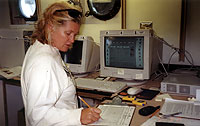|
|
Journals 2003/2004
Lynn Masellis
McGinnis Middle School, Perth Amboy, NJ
"Late summer ecosystem monitoring survey"
R/V Argo Maine, Gulf of Maine
August 19 - 30, 2003
|
DAY 2: Wednesday, August 20, 2003
I awoke to the wake up call by John Sebunka at 5:10 for breakfast at 5:30. He was the lucky guy that got to wake me up everyday of the trip. It was my most "unfavorite" moment of the day and probably his greatest. He was getting off shift and I was to begin mine. Well-- I got dressed very slowly, between the crummy way I felt and the swaying I was doing, --I was pretty jumbled. I wondered, what did I get myself into? After bouncing back and forth for some time I made my way upstairs to the lab. Everyone was running around keeping busy. I was busy holding back last nights' dinner. And after 15 minutes of being useless, I asked to go back to the "land down under". When the scientists stopped to look at me I was white as a ghost, they suggested I take a bucket with me. I felt something coming on. I took some seasickness medicine and went back to sleep.
Jerry Prezioso my scientist partner kept checking on me and later in the afternoon I got up to eat and I was ready to take on my shift. The night shift began at 6 p.m. and I watched how Jerry, and the second mate Dave worked together to set up the CTD and the bongos. I stayed inside and recorded data as it came in. Jerry told me step by step how to record the station location, the time, date, depth, and other various data concerning the results of our sampling. I was very nervous about screwing it up so I asked Jerry each step of the way. What a nice patient man he is!
 First we checked the flow monitors and recorded the beginning numbers. Then we changed to tubing to the CTD and attached the big bongos to the CTD line. From time to time we would also attach the baby bongos too. Then we checked our location, depth, and time and turned the switch to the CTD on. We would check the computer monitor to make sure it was ready to record data, and then we would sink the bongos, and the CTD computer into the ocean. Our goal was to have them drift down to the bottom, but when they came within five meters of the bottom we would signal the captain and he would retrieve the bongos and bring the line with the bongos and CTD to the surface. After the equipment came on board we would have our totals of time, flow, salinity and temperature that were to be confirmed and recorded on the computer program. The nets from the bongos had to be hosed down and all the samples preserved in a specific labeled jar. This sample would then be shipped to Poland to be analyzed. At times Jerry and I would observe parts of the sample under a microscope. It was fascinating to see and identify different forms of aquatic life. It is quite amazing how these microscopic animals live and breed in the deep blue sea.
 As the night endured, Jerry and I discussed everything from the weather to what we wanted for Christmas. There was hours in between stations and would usually spend them taking about life, the people in our lives and past experiences. Its was nice to share and get along so well especially went times got a little rough on the sea.
That night I went to my room for a little break. Jerry was in the lab area reading. When we finished labeling samples from the last station, the boat rolled a bit and when it rocked, a small measuring cup dropped into the drain. Jerry was still reading right near the sink. It began flooding the lab until we noticed the waterfall coming from the sink. Jerry didn't freak out he just solved the problem and told me of it later when I was gearing up for bed. He is a problem solver. Thank -God for my easygoing partner. A bit later I got ready for bed and once again said my prayers and thanked the Lord I made it through my first day on duty.
|
|